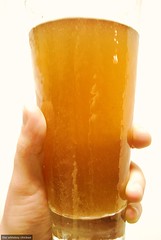 |
| Behold! Perry! |
New Year's Eve has come and gone, during which I finally popped open the first bottle of hard cider I brewed late last year. Results? Um, well it was ok. At first swig it is everything I wanted my cider to be: gorgeous golden blush color, good nose, lightly carbonated, sweet and peary. But then it finishes into a very strong sour note that isn't all that different from a Lambic. Which is not exactly a bad thing, but pretty jarring if you aren't expecting it, and not what I was going for.
However I purposely didn't pasteurize the juice before brewing, so I can't be too surprised. I am a bright shade of apple (or pear?) green when it comes to brewing, but I believe the sour kick at the end is the result of wild yeasts from the pear juice. Any thoughts? While it didn't turn out exactly as planned, I am still pleased with the outcome. The process was a blast and I now have a drinkable cider I made myself. Plus it's just damn cool. So how does one make Perry you ask? Well I'll give you a quick rundown, just forgive me for lack of pictures. Like I said, I am working on this photo documenting thing so bear with me.
First you need pears. No problem there, my trees give me enough to feed a small pear-loving town. I don't know the variety, but they are very hard and mildly sweet. I needed enough pear juice to fill a 5 gallon glass carboy, which is A HELL OF A LOT.
 |
| About half of a hell of a lot |
I used a juicer to juice up the pears, which only took about 3 hours... I'm thinking next time I will rent an apple press. I added 1lb. of honey, and an English lager yeast. Then I slapped on the airlock and kept it in a dark and somewhat cool place for about 1 month. I then racked it into another carboy to remove some of the sediment, and let it sit again for roughly 1 month. Finally, I bottled it all into lovely green Champagne bottles, and corked them using plastic corks which I could put in (not so easily) by hand. Before bottling I added a very small amount (about 2 cups) of organic apple cider to the brew, as well as a small amount of sugar to each bottle to give the yeast something to chew on in the hopes of a little added carbonation. Then I bottled and let sit for just under, you guessed it, 1 month.
Now did I need to let the cider sit that long? Nope. I did take my time in the beginning after reading that honey can slow fermentation, but really I was just procrastinating. Luckily when making cider that is ok to do. So juicing aside, the process was very easy and fun to do. And I got 15 bottles out of my first batch, most of which I shared as Christmas presents. Next time I foresee using an apple press and pasteurizing the juice beforehand, but all in all I am thrilled with the outcome and can't wait to brew again. Next up, brown ale!
Very nice, I remember when you were looking for an apple press but assumed you were making regular apple cider. I'd be interested to try a bit of this. Let me know if you ever try brewing beer, I'd be interested to check out that process.
ReplyDeleteI have a bottle with your name on it! I am hopefully going to start on a brown ale this weekend.
ReplyDeleteBeautiful!!! I haven't brewed anything in a while, and I've never though one could produce 5 gallons of juice with a simple juicer! I guess I should get to work.
ReplyDeleteThank you! It certainly took AWHILE using my juicer, but it can be done.
ReplyDeleteWith pears, you can also make "poiré" !This is grat but you must have a bottle washer to do it...
ReplyDeleteI'm thinking that the tartness that you're referring to is due to the high citric acid level in pears. Certain bacteria can convert this to acetic acid, which is essentially vinegar. I wouldn't recommend home pasteurizing the juice, seeing as it will change the flavor. If you add some campden to it you can avoid the problem without changing the flavor though.
ReplyDeleteI would like to taste poiré .. how big is a bottle washer ?
ReplyDeleteI use a similar technique. Except I don't add any sugar other than the carbonation addition. I ferment at between 18 and 22 degrees C and keep it in the carboys to bulk age (racking of course) for around 7 or 8 months then bottle. Finally popping the cork 4 months latter. So my pear cider is about twelve months old before it is tasted. And at around that time I am looking to harvest my next crop. I agree with you about those corks. It's not easy. Cheers
ReplyDelete